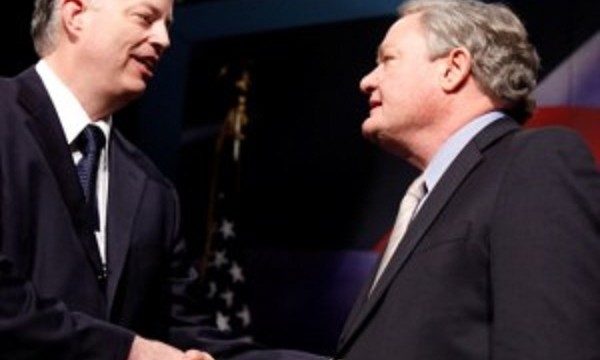Paul Sorum Says He May Be On June Ballot For Governor As A Republican

The number of Republican gubernatorial candidates in North Dakota’s 2016 election cycle just went up to four, it seems.
Currently state Rep. Rick Becker, Attorney General Wayne Stenehjem, and Fargo businessman Doug Burgum are vying for the North Dakota Republican Party’s nomination to run for the office. Now Paul Sorum, who was on the statewide ballot as an independent in 2012, says there are people circulating a petition to put him on the June ballot seeking the Republican nomination.
“There are people out there circulating a nominating petition for a candidate who is truly pro-life and pro-traditional marriage,” Sorum told me this morning. I asked him how the signature collection was going. “I’m not involved in that. I think they’re in the early stages,” he told me.
He did say that if they got the signatures to put him on the June ballot he would “probably” accept.
“They’re not truly pro-life,” Sorum said of the other candidates in the race. “There’s not a candidate who believes in traditional marriage. The people circulating the petition want that option on the ballot in the primary.”
Getting on the June ballot as a candidate for party endorsement is easy. One needn’t even bother attending attending the political party’s endorsing convention. All you need is 300 signatures between January 1 and April 11 and you can put yourself on the statewide ballot as a Republican or a Democrat or a Libertarian. Sorum tells me he would definitely run as a Republican.
[mks_pullquote align=”right” width=”300″ size=”24″ bg_color=”#ffffff” txt_color=”#000000″]”There are people out there circulating a nominating petition for a candidate who is truly pro-life and pro-traditional marriage,” Sorum told me this morning.[/mks_pullquote]
If Sorum is on the ballot, it could be an interesting development for what is already expected to be a tight June race. Although Becker, Burgum, and Stenehjem are currently attending local district conventions trying to convince delegates there to support them at the statewide convention in April, Burgum specifically has said he’ll push on to the June ballot if he loses at the convention (which he has said he probably will). Becker and Stenehjem, meanwhile, have said they’ll abide by the convention outcome. Burgum would probably beat Becker on the statewide ballot, but a Stenehjem versus Burgum race could be a close one (I’d give Stenehjem the edge as things stand now).
But a three way race? That’s a different dynamic. Not because Sorum could get a large percentage of the vote, but because the race could be so tight that every percentage point matters. Also, Sorum is clearly going to run as a social conservative, and he’s right in identifying that the social conservatives don’t really have a champion in this race currently.
If anything Sorum would probably pull more votes from Stenehjem than Burgum in the primary vote. Burgum is pretty far to the left on social issues. So much so that he likely made Stenehjem look more appealing to social conservatives. But if social conservatives have someone like Sorum available to vote for? They won’t go over in droves, mind you, but some will and those people were probably more likely to vote for Stenehjem than Burgum.
Sorum, meanwhile, has something of a long, strange history in North Dakota politics.
In 2010 Sorum emerged from the state’s tea party protests to challenge then-Governor John Hoeven from the right for the NDGOP’s nomination for the U.S. Senate race. Hoeven won easily, but Sorum got a respectable 21 percent of the delegate vote.
In 2012 Sorum again ran for statewide office, this time challenging Governor Jack Dalrymple for the NDGOP nomination. Sorum lost again, but again got a respectable turnout among state convention delegates with 29 percent.
Despite losing the convention vote, Sorum went ahead and put himself on the November ballot anyway as an independent. He and his Lt. Governor candidate Michael Coachman got a total of 5,356 votes, or about 1.69 percent of the total.
After the 2012 election, Sorum tried to overturn the outcome with a lawsuit claiming that both the Republican and Democrat candidates hadn’t been legal candidates. Sorum’s argument (more here) was that state law requires a political party’s governor and lieutenant governor candidates to be submitted as candidates on the same form. Due to a snafu in the Secretary of State’s office which produced forms with a blank for governor but not lieutenant governor both the Democrats and the Republicans submitted their candidates on separate pieces of paper.
Based on that Sorum wanted the more than 309,000 votes – representing over 97 percent of the total – cast for the Republican and Democrat candidates thrown out so that he could be named governor.
Instead Sorum’s lawsuit got thrown out. Which was proper. A minor paperwork glitch shouldn’t invalidate the will of 97 percent of the electorate.
During his 2012 run as an independent Sorum contacted left-wing activsts about using North Dakota’s grand jury petition process to try and indict Governor Jack Dalrymple on bribery charges. The idea being that political contributions to Dalrymple’s campaign from the oil industry were somehow bribes. The New York Times mentioned the zany idea in their hit piece on North Dakota last year, but it didn’t get a lot of traction in court.
The grand jury petition process allows for someone to be indicted if petitioners collect signatures equal to a certain percentage of the vote for governor in a given county. The petitioners out to indict Dalrymple shrewdly took their case to extremely rural Dunn County where that percentage calculated out to just a couple of hundred votes needed.
But, not surprisingly, they still struggled to get the valid signatures.




